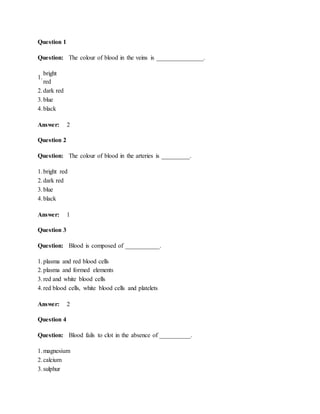transportation in living thing
- 1. Question 1 Question: The colour of blood in the veins is _______________. 1. bright red 2.dark red 3.blue 4.black Answer: 2 Question 2 Question: The colour of blood in the arteries is _________. 1.bright red 2.dark red 3.blue 4.black Answer: 1 Question 3 Question: Blood is composed of ___________. 1.plasma and red blood cells 2.plasma and formed elements 3.red and white blood cells 4.red blood cells, white blood cells and platelets Answer: 2 Question 4 Question: Blood fails to clot in the absence of __________. 1.magnesium 2.calcium 3.sulphur
- 2. 4.potassium Answer: 2 Question 5 Question: Transpiration takes place from ________________. 1.all parts of the plant 2.leaves 3.only the aerial parts 4.stem Answer: 3 Question 6 Question: Stomata are present on the __________ of the leaves. 1.upper surface only 2.lower surface only 3.mostly upper surface 4.mostly lower surface Answer: 4 Question 7 Question: The cells that are full of water and rigid are called ________. 1.support cells 2.flaccid 3.turgid 4.none of the above Answer: 3 Question 8 Question: Much of the transpiration takes place through ___________.
- 3. 1.stomata 2.lenticels 3.cuticle 4.epidermis Answer: 1 Question 9 Question: The roots absorb water through _______________. 1.epidermal hairs 2.root hairs 3.root xylem 4.root phloem Answer: 2 Question 10 Question: The ascent of sap in plants takes place due to __________. 1.root pressure 2.transpiration pull 3.both a and b 4.osmosis Answer: 3 Question 11 Question: Stomata open and close due to _____________. 1.presence of valves 2.hormonal control 3.turgor pressure of guard cells 4.concentration gradient of the gases Answer: 3 Question 12
- 4. Question: Minerals are absorbed into the cells by _____________. 1.osmosis 2.diffusion 3.active transport 4.a, b or c Answer: 3 Question 13 Question: The liquid portion of the blood is called __________. 1.water 2.plasma 3.serum 4.sap Answer: 2 Question 14 Question: The right side of the heart deals with ___________. 1.oxygenated blood 2.deoxygenated blood 3.mixture of oxygenated and deoxygenated blood 4.either a or b at a time Answer: 2 Question 15 Question: __________ carries oxygenated blood. 1.pulmonary artery 2.hepatic portal vein 3.pulmonary vein 4.all of the above Answer: 3
- 5. Question 16 Question: Deoxygenated blood is carried by ______________. 1.pulmonary artery 2.hepatic vein 3.renal vein 4.all of the above Answer: 4 Question 17 Question: The threads formed during clotting are made up of _____. 1.thrombin 2.prothrombin 3.fibrinogen 4.fibrin Answer: 4 Question 18 Question: The double membraned structure surrounding the heart is called _____________. 1.plasmalemma 2.pleural membrane 3.tonoplast 4.pericardium Answer: 4 Question 19 Question: An example of lymph gland is ________________. 1.spleen 2.liver 3.tonsil 4.thyroid
- 6. Answer: 3 Question 20 Question: Human circulatory system is called double circulation because of ___________. 1.systemic and hepatic portal system 2.hepatic portal and pulmonary system 3.systemic and pulmonary circulation 4.systemic, hepatic and pulmonary circulation Answer: 3 Question 21 Question: Pulse beat is measured in _____________. 1.nerve 2.artery 3.vein 4.heart Answer: 2 Question 22 Question: Thick muscular walls are present in ___________. 1.arteries 2.arterioles 3.veins 4.venules Answer: 1 Question 23 Question: Diapedesis is shown by _______________. 1.RBC 2.WBC
- 7. 3.platelets 4.a,b and c Answer: 2 Question 24 Question: The main cells present in lymph are ___________. 1.red blood cells 2.platelets 3.lymphocytes 4.monocytes Answer: 3 Question 25 Question: The normal blood pressure in man is ___________. 1.80/120 mm Hg 2.120/80 mm Hg 3.120/100 mm Hg 4.100/80 mm Hg Answer: 2 Question 26 Question: The opening between the right auricle and the right ventricle is guarded by the _____. 1.tricuspid valve 2.bicuspid valve 3.semi-lunar valve 4.mitral valve Answer: 1 Question 27
- 8. Question: The food is transported in the phloem in the form of ______. 1.glucose 2.sucrose 3.amino acids 4.fats Answer: 2 Question 28 Question: The fluid that does not form clots is ___________. 1.blood 2.plasma 3.lymph 4.serum Answer: 4 Question 29 Question: The smallest blood vessel in the body is a _____________. 1.vein 2.vena cava 3.capillary 4.venule Answer: 3 Question 30 Question: The blood vessel carrying blood from heart to the lungs is called ___________. 1.carotid artery 2.carotid vein 3.pulmonary artery 4.pulmonary vein Answer: 3
- 9. Question 31 Question: Valves are present in ___________. 1.arteries 2.arterioles 3.veins 4.capillaries Answer: 3 Question 32 Question: The movement of particles from the region of their higher concentration to the region of their lower concentration is called as ________________. 1.osmosis 2.diffusion 3.active transport 4.ascent of sap Answer: 2 Question 33 Question: A portal vein runs from 1.an organ to the heart 2.the heart to an organ 3.one organ to another 4.an organ to the vena cava Answer: 3 Question 34 Question: Deoxygenated blood is received by the __________. 1.left auricle 2.right auricle 3.left ventricle
- 10. 4.right ventricle Answer: 2 Question 35 Question: Mitral valve is the other name for ________________. 1.semilunar valve 2.bicuspid valve 3.tricuspid valve 4.venous valves Answer: 2 Question 36 Question: Lacteals in the intestine take up ______________. 1.digested starch 2.digested fats 3.digested proteins 4.glucose Answer: 2 Question 37 Question: Semilunar valves guard the junction of _____________. 1.left ventricle and aorta 2.right ventricle and aorta 3.left ventricle and pulmonary artery 4.right ventricle and pulmonary vein Answer: 1 Question 38 Question: Antibodies are produced as a reaction to the presence of _______________.
- 11. 1.red blood cells 2.haemoglobin 3.antigens 4.white blood cells Answer: 3 Question 39 Question: Red blood cells are destroyed in the ____________. 1.lungs 2.liver 3.heart 4.spleen Answer: 2 Question 40 Question: Red blood cells are _____________. 1.biconcave discs 2.biconvex discs 3.cylindrical 4.spherical Answer: 1 Question 41 Question: Thrombocytes is the other name of _____________. 1.RBC 2.WBC 3.platelets 4.lymphocytes Answer: 3










